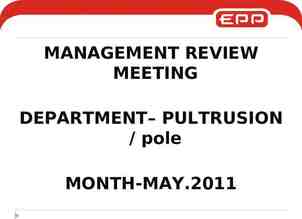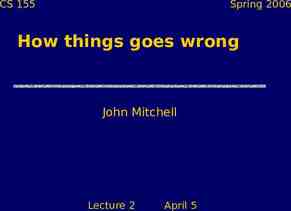Reason for Forecasting and Its Techniques 1
14 Slides136.50 KB
Reason for Forecasting and Its Techniques 1
Overview Why Forecast? An Overview of forecasting techniques Basic steps in a forecasting task 2
Vocabulary Lead time There is a time lag between the time an “about to happen event” and the actual occurrence of the event is called the lead time. 3
Why Forecast? 1) 2) Uncontrollable external events Example: those that originate with the national economy, governments, customers. Controllable internal events such as marketing or manufacturing decisions within the firm. 4
Why Forecast? Forecasting applies to the 1) while decision making applies to 2) Planning links 1) & 2). Please see page 4 of the textbook: Forecasting: Methods and Applications, by Spyros Makridakis, Steven C. Wheelwright, and Rob J. Hyndman. ISBN 0-471-53233-9 John Wiley and Sons, Inc. 5
Role of Forecasting In the following areas Scheduling: Forecasts the level of demand for 6
Its role continued . Acquiring resources: Lead time to acquire raw materials, etc. Determining resource requirements: Long term planning. 7
An Overview of Forecasting Techniques Quantitative: Sufficient quantitative information is available. It depends on judgment and accumulated knowledge. Used to formulate Strategy, long-range plans, etc. 8
Quantitative data Time series: Predicting the continuation of historical patterns (trends) such as the growth of sales or gross national product (GNP) GNPt 1 f(GNPt, GNPt-1, ., error) Explanatory: Understanding how explanatory variables such as prices and advertising affect sales. GNP f(monetary &fiscal policies, inflation, capital spending, import, export, ., error) Need to know “how” to predict and not the “why” 9
Qualitative: Qualitative: Little or no quantitative information is available, but sufficient qualitative knowledge exists. Predicting the impact of gasoline price if and when it hits 3.00 per gallon. 10
Qualitative continued Predicting the discovery of a new, very cheap form of energy that produces no pollution. Predicting the speed of telecommunications around the year 2020. 11
An Overview of Forecasting Techniques Unpredictable: little or no information is available. Predicting the effects of interplanetary travel. Predicting the discovery of a new, very cheap form of energy that produces no pollution. 12
When Can One Do Quantitative Forecasting? Information about the past is available. 2. This information is available in the form of numerical data 3. Assumption of continuity: It can be assumed that some aspects of the past pattern will continue into the future. Continuity assumption is also need for qualitative forecasting 1. 13
Why Forecasting Works? Some aspects of the history do repeat themselves in a sense. 14



















